Hobart and William Smith Queensland Term 1996
Academic Program
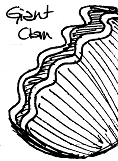
- Introduction
- Lecturer Profiles
- Course Descriptions
- Guest Lecturers
- Field Work
- Resources: Biodiversity and the Australian Environment
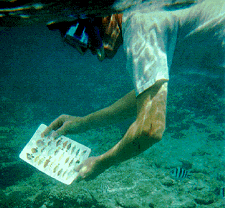 Four courses comprised the formal academic program of the 1996 HWS Term in Queensland.
The course titles were: (1) The Biology of Australian Plants
and Animals,
(2) Australian Culture and Society, and finally
statistics courses taught at two different levels (3) Bio 212 Biostatistics and
(4) Bio 312 Advanced Biostatistics.
Four courses comprised the formal academic program of the 1996 HWS Term in Queensland.
The course titles were: (1) The Biology of Australian Plants
and Animals,
(2) Australian Culture and Society, and finally
statistics courses taught at two different levels (3) Bio 212 Biostatistics and
(4) Bio 312 Advanced Biostatistics.
Two faculty from the University of Queensland,
Dr David Yates of the Department of Botany and
Dr Ian Tibbetts
of the School of Marine Science, provided the core of lectures for the Australian
Plants and Animals course, supplemented by
guest lecturers.
The Australian Society and Culture Course was taught by Dr Richard Nile, head
of the Australian Studies Program at the University of Queensland.
The statistics courses were taught by Dr Thomas Glover of the Department of Biology
and Dr Kevin Mitchell of the Department
of Mathematics and Computer Science at Hobart and William Smith Colleges.
Fish identification in the Coral Gardens at Lady Elliot Island.
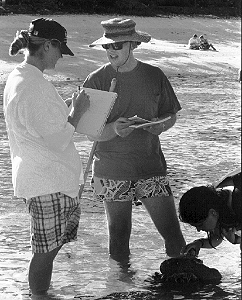 Dr Ian Tibbetts
Dr Ian Tibbetts
Raised in the south west of England, Ian spent his early years fossicking on the shores
of the English Channel. He pursued his interest in marine life by taking an honours
degree in Marine Biology at the University of Wales and then travelled to Australia to
commence a Ph.D. in Zoology.
Alongside the research for his thesis, Ian became involved in teaching marine biology,
both to undergraduate students and to visitors to Australia. Various opportunities led
to him to continue his involvement with community and undergraduate education, and
work for the Australian Government fisheries research organization. For a period, Ian
was involved in the management of educational travel programs with the TraveLearn
unit at The University of Queensland.
Upon completion of his PhD studies on the biology and ecology of garfish he took a
lecturing position in the
School
of Marine Sciences at the University of Queensland
where he currently administers the business of the School, gives undergraduates
lectures on marine biology and supervises postgraduate students in fish biology and
ecology.
Marine zoologist
Ian Tibbetts discusses field projects with students on Lady Elliot Island (1994).
He is currently the Secretary of the Australian Coral Reef Society and Editor of the
Australian Marine Science Bulletin. He lives near the shores of Moreton Bay with his
three children, Daniel, Hannah, and Rachel.
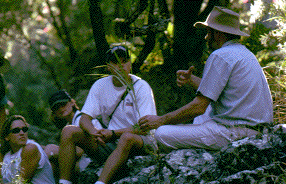 Dr David Yates
Dr David Yates
David Yates has been a member of the Botany
Department at The University
of Queensland for 17 years and a university teacher for over 20 years. He
holds a Bachelor of Agricultural Science and Doctor of Philosophy Degrees
from The University of Melbourne and has almost completed a Graduate
Diploma in Teaching (Further Education and Training).
David is a keen teacher and teaches science and agricultural science
students in a variety of subjects relating to plants and their environment,
aspects of plant ecophysiology and rainforest biology. His doctoral
research related to the importance of the angle of sunlight on the leaves
of crop plants. His current research interests include aspects of the
microclimate of rainforests and how light interacts with plant leaves.
Botanist David Yates with
students at Mt Coot-tha.
He lived and worked in Indonesia for two and a half years and has returned
there several times. He recently returned from conducting his second
Indonesian Study Tour for botany, ecology and agricultural science
students.
David is married to Jill who works teaching English to newly arrived
migrant children for the Queensland Government. She also acted as a
leader of the Indonesian Study Tours. They have two sons, one of whom is
taking the second year of a Bachelor of Engineering degree, and the other
is still in High School.
Students developed a very close relationship with both Yates and
Tibbetts (first name basis), which was fostered by the field trips. It was
clear that Yates and Tibbetts had the needs of the HWS students foremost in
the design of the program.
The flora and fauna endemic to the Australian continent were the primary foci
of the course. Through the four major field trips, habitats such as the Great
Barrier Reef, rainforests, and the Bush were studied in detail.
The plants and animals course was reorganized as an Australian
marine and terrestrial biology course since each of the
field trips had a distinct marine or terrestrial
focus which always included a plant and an animal component.
Assessment: Grading for the course was based on a poster project describing
the natural history of one of the program's field sites, a final exam (see below),
a report based on the terrestrial field exercises
carried out at Stradbroke Island and Lamington, and an individual or small
group project based on the marine field work carried out on Stradbroke
and Lady Elliot Islands.
Study Areas for the Final Exam in Biology 231
The Final Examination in this subject will involve three sections, one
relating to Marine topics, one to Terrestrial topics, and one with more
general questions. Each question will comprise two sections, both of
which you must answer. That is, there is no choice on the examination paper.
To provide some guidance for you, nine questions are provided below,
categorised into the three areas of the examination. Three questions
are given in each area, of which only two will occur on the examination paper.
These questions are prepared to give you the opportunity to draw on the widest
possible sources you may have available at your disposal. Students are
encouraged to discuss these questions amongst themselves prior to the examination.
- Marine
- Our explorations of rocky shores revealed some apparent patterns in
the distribution of organisms and their responses to the physical
environment.
- Describe, compare and contrast the habitats, fauna
and flora of intertidal rocky shores of Polka Point and Lady Elliot Island.
- Select three organisms, one each of (i) an entirely
sessile species (e.g., barnacle), (ii) a weakly mobile species (e.g., snail)
and (iii) a highly mobile species (e.g., crab), and discuss how each might
respond to the challenges of life in intertidal areas.
- Australia's marine biota is among the most diverse on the planet.
It is composed of a tropical component typical of Indo-Pacific seas,
and a warm, temperate component which exhibits very high levels of endemism
(species unique to a region). (A) Describe how this pattern of marine diversity
established in Australian seas (Hint: continental drift, sea level changes, etc);
and (B), discuss current processes that are thought to support marine
diversity (Hint: competition, grazing, etc).
- Marine environments are particularly rich in examples
of intricate relationships between organisms. Such relationships
may range from low order interactions where animals merely occupy
the same environment to higher order interactions where animals
live in very close, sometimes obligate, association. Discuss,
with examples, symbiosis in marine systems.
- Terrestrial
- Australia is often considered to have unique fauna and flora because
of its apparent age. Briefly discuss attributes of typical Australian
animals that make them different from animals of other continents.
- Why do Australian plant communities differ so much from each other?
Compare and contrast three Australian plant communities discussing how
they differ and suggesting why these differences might occur.
- The Australian continent is considered to be the driest of all continents.
Discuss the implications of this dryness for terrestrial organisms.
Use examples to illustrate both the impact of aridity on organisms,
and the anatomical, morphological and physiological adaptations that
appear to be advantageous in an arid climate.
- General
- Choose one organism or community you have encountered or learnt
about during your period in Australia and which is threatened by
humans. Briefly outline reasons the organism/community is threatened,
what these threats are from a biological/ecological point of view, and
how you would suggest that the threat be handled.
- Suppose, as your first job after graduation, you became involved with
a project to preserve a particular threatened species. Part of the
business community wants to undertake a development that will seriously
threaten the remaining population of that species. As an educated person
you have most of the necessary scientific knowledge that would allow you
to do a good job of protecting the population. Outline the arguments and
information you would use with a relatively uneducated business-person
(and the local community) in an attempt to persuade them not to proceed
with the project.
- Discuss the statement: "Coral reefs are the ecological
equivalent of rain forests"
The Final Paper for the Terrestrial Component of Biology 231:
The material for this may be drawn from any material
presented in lectures, field trips, books or papers you have read, or indeed
any reliable source. The aim of this exercise is for you to integrate and
apply some of the information you obtain.
The primary tasks you will undertake in the essay are described below.
- From a biological perspective, compare and contrast two
environments you have encountered during your time in Australia.
- For the environments you have selected, compare and contrast the
"problems" you consider are faced by the organisms that occur there
naturally. (You may like to comment on the adaptations of organisms
to these environments and what the origin and significance of these
adaptations might be.)
- Considering both the environments and the organisms that occur
there naturally, briefly discuss what you consider to be the
pressures on those environments and organisms as a result of human
activities (include tourism, extractive industries, general industry,
recreation, residential developments or any other human activities).
Where possible, discuss the similarities and differences between
the two environments you have considered.
Examples of two papers are
Light Characteristics in Open-forest
and Closed-forest Communities by Christine Parker and
Fauna Species Diversity of the
Subtropical Rainforest of Lamington National Park versus that of the
Schlerophyll Forest of North Stradbroke Island by Jackie Lamme.
The Projects for the Marine Component of Biology 231
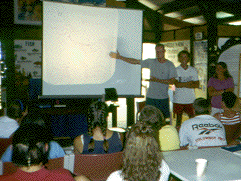 Topics for the final projects for the marine component were selected by the
students in consultation with the faculty for the program.
Some students worked
alone, others in groups of two or three.
Topics for the final projects for the marine component were selected by the
students in consultation with the faculty for the program.
Some students worked
alone, others in groups of two or three.
Preliminary reports
for each project were given at Lady Elliot Island. Here
Mike Conn '97, Rebecca Price '97, and Todd Pauliny '97 report
on their project involving crab behavior.
Groups reported on the projects they completed at Lady Elliot, many of which
involved a comparison study at Stradbroke Island.
Project topics included:
- Distribution of snails in the intertidal zone
- Distribution of sea stars
- Distribution of sponges on different size boulders
- Sponge symbionts
- Human impact on coral
- Giant clams: Color versus depth and angle of orientation
- Diversity and the intermediate disturbance hypothesis
- Relative importance of various holothurians
- Chiton distributions and natural history
- Distribution and importance of sea cucumbers
- Sargassum and coral symbionts
- Trochids: A nearest neighbor analysis
- Hermit crabs and their preferences for homes
For examples of papers, see Migration of Gastropods
by Steve Smith and Branching patterns of coral
by Mike Markzon.
Dr Richard Nile, Director of the University of Queensland's Australian Studies
Program, provided all of the lectures for the course. The lectures and
the reader that he developed for
the course examined the following topics:
- Aboriginality as Civilization
- Inventing Australia
- A Brief History of Australia
- Convict Workers
- Creating a Nation
- The Australian Legend
- The Meaning of Mateship
- The Cultural Cringe
- Egalitarianism
- The Anzac Tradition
- War and Literature
- Identity
- Denaturalizing Cultural Nationalisms
Assessment: Grading
for the course was based on a proposal and annotated bibliography for a final
paper and the final paper itself. The topics for the papers were selected in
consultation with Dr Nile. For example, Chris Parker's final paper was
An Investigation
of The Australian Passion For Sport
Though Yates and Tibbetts were in charge of the biology and biodiversity
courses, much of the lecturing in Brisbane was carried out by guest
lecturers (17 in all). The
local staff lectured on areas of their own particular expertise, so
students had a wonderful opportunity to hear first-rate people. The complete list of
guest lecturers and their topics, including those at field locations,
follows.
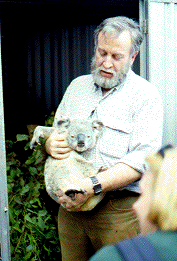
- Dana Bergstrom: Australian Vegetation: (1) Mangroves and Coastal Vegetation and (2) Arid Zones and Mountains, (3) Mountains and Heathlands, (4) Rainforests
- Leslie Newman: (1) Diversity of Marine Animals, (2) Invertebrate Form and Function, (3) Symbiosis in Coral Reefs
- Frank Carrick: (1--2) Australian Fauna, (3) Marsupial Biology (shown
in photo at UQ Vet Farm)
- Mark O'Donahue: Marine Primary Productivity
- Peter Johnson: Introduction to the Ecology of Moreton Bay
- Tim Hamley: The Ancient Fauna of Australia
- Anita Smythe: (1) Birds of Australia, (2) Birds and Animals of the Rainforest (at Lamington)
- Don Butler: The Ancient Flora of Australia (at Lamington)
- Chris Pavey: Trapping Methods for Rainforest Animals (at Lamington)
- Kathy Townsend: Poisonous and Venomous Animals on the Reef (at Lady Elliot Island)
- Tom Cribb: Biodiversity, Symbiosis, and the Species Concept (1--2)
- Alan Cribb: The Marine and Terrestrial Fauna of the Great Barrier Reef
- David Neil: History and Management of Australian Natural Resources
- Darrel McPhee: Australian Aquaculture
- Peter Hale: Whales and Dolphins
- Lloyd Hancock: Informal lectures on (1) Geology and Ecology of Carnarvon Gorge, (2) Aboriginal Culture in Eastern Australia (at Saddler Springs)
- Gavin Enevra: Informal lectures on (1) Aboriginal Culture in Central Queensland (2) Management Issues in Rural National Parks (National Park Service at Mt Moffat)
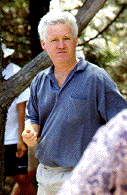
- Peter Foote, CRL: Informal lecture on Revegetation of Sand Islands
(Shown in photo at CRL on North Stradbroke Island)
- David Watson, MP: Informal lecture on the Australian Political System (at the Queensland Parliament)
- David Graham, James Walle, Kathy Townsend, Anita Smythe, and Chris Pavey acted as field assistants on field trips.
The cornerstone of the HWS Queensland Term was field work. The field sites were the
laboratory facilities for the program, not just "add ons"
or excursions. Included in the program were four major working field trips.
For each trip, there were preparatory and/or on site lectures. At
each location, human pressures on the particular ecosystem and
management of resources were discussed.
 A five day trip to North Stradbroke Island
A five day trip to North Stradbroke Island
Here students use a seine net at high tide at Polka Point.
Both day and night seinings were done at consecutive
high tides with the data collected showing much more
activity by a wider variety of species at night. Species
captured during the day were mullet, garfish, whiting,
flathead, porcupine fish, and silver biddy. Those caught
at night included mullet, hardy head, gerres, garfish,
whiting, bream, flathead, puffer fish, cuttlefish, and
small rays.
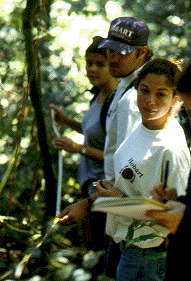 A five day trip to Lamington National Park
A five day trip to Lamington National Park
Here students collected data to using the point-centered quarter method
to determine the relative importance of various tree species in disturbed
areas.
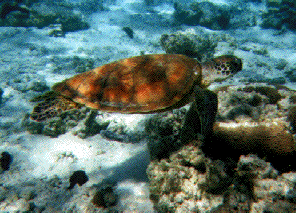 A five day trip to Lady Elliot Island
A five day trip to Lady Elliot Island
Among the many spectacular sites seen while snorkeling
at Lady Elliot were loggerhead turtles
which use the island as a nesting site.
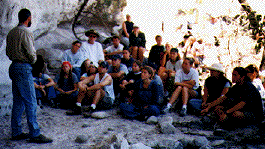 A six day trip to Carnarvon Gorge
(Saddler Springs, Mt. Moffat)
A six day trip to Carnarvon Gorge
(Saddler Springs, Mt. Moffat)
Gavin Enevra of the Queensland National Parks Service
discuss the effects of human impact on the sacred sites of the aboriginal
peoples that once lived in the Mt Moffat section of Carnarvon National Park.
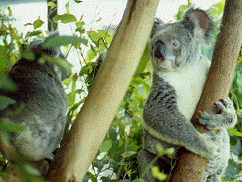 There were also three half-day field trips in the program.
The first was to
Mt Coot-tha,
a 20-minute drive from the University of Queensland
campus. Our work there consisted of a series
of data collection exercises that introduced students to techniques that they would
use later in the program. The second half-day excursion was to the
University of Queensland Veterinary Farm for a lecture on marsupial
biology and some "hands on" interaction with koalas. The final trip was a
visit to the Queensland Parliament.
There were also three half-day field trips in the program.
The first was to
Mt Coot-tha,
a 20-minute drive from the University of Queensland
campus. Our work there consisted of a series
of data collection exercises that introduced students to techniques that they would
use later in the program. The second half-day excursion was to the
University of Queensland Veterinary Farm for a lecture on marsupial
biology and some "hands on" interaction with koalas. The final trip was a
visit to the Queensland Parliament.
Return to the
Home Page for Hobart and William Smith Colleges' 1996 Queensland Term
Author: Kevin Mitchell (mitchell@hws.edu)
Last Update: 18 June 1997
 Dr David Yates
Dr David Yates
 Four courses comprised the formal academic program of the 1996 HWS Term in Queensland.
The course titles were: (1) The Biology of Australian Plants
and Animals,
(2) Australian Culture and Society, and finally
statistics courses taught at two different levels (3) Bio 212 Biostatistics and
(4) Bio 312 Advanced Biostatistics.
Four courses comprised the formal academic program of the 1996 HWS Term in Queensland.
The course titles were: (1) The Biology of Australian Plants
and Animals,
(2) Australian Culture and Society, and finally
statistics courses taught at two different levels (3) Bio 212 Biostatistics and
(4) Bio 312 Advanced Biostatistics.  Dr Ian Tibbetts
Dr Ian Tibbetts Topics for the final projects for the marine component were selected by the
students in consultation with the faculty for the program.
Some students worked
alone, others in groups of two or three.
Topics for the final projects for the marine component were selected by the
students in consultation with the faculty for the program.
Some students worked
alone, others in groups of two or three.

 A five day trip to North Stradbroke Island
A five day trip to North Stradbroke Island A five day trip to Lamington National Park
A five day trip to Lamington National Park A five day trip to Lady Elliot Island
A five day trip to Lady Elliot Island A six day trip to Carnarvon Gorge
(Saddler Springs, Mt. Moffat)
A six day trip to Carnarvon Gorge
(Saddler Springs, Mt. Moffat) There were also three half-day field trips in the program.
The first was to
Mt Coot-tha,
a 20-minute drive from the University of Queensland
campus. Our work there consisted of a series
of data collection exercises that introduced students to techniques that they would
use later in the program. The second half-day excursion was to the
University of Queensland Veterinary Farm for a lecture on marsupial
biology and some "hands on" interaction with koalas. The final trip was a
visit to the Queensland Parliament.
There were also three half-day field trips in the program.
The first was to
Mt Coot-tha,
a 20-minute drive from the University of Queensland
campus. Our work there consisted of a series
of data collection exercises that introduced students to techniques that they would
use later in the program. The second half-day excursion was to the
University of Queensland Veterinary Farm for a lecture on marsupial
biology and some "hands on" interaction with koalas. The final trip was a
visit to the Queensland Parliament.